technical specifications Alfa Romeo Giulietta 2013 Owner handbook (in English)
[x] Cancel search | Manufacturer: ALFA ROMEO, Model Year: 2013, Model line: Giulietta, Model: Alfa Romeo Giulietta 2013Pages: 292, PDF Size: 13.06 MB
Page 126 of 292
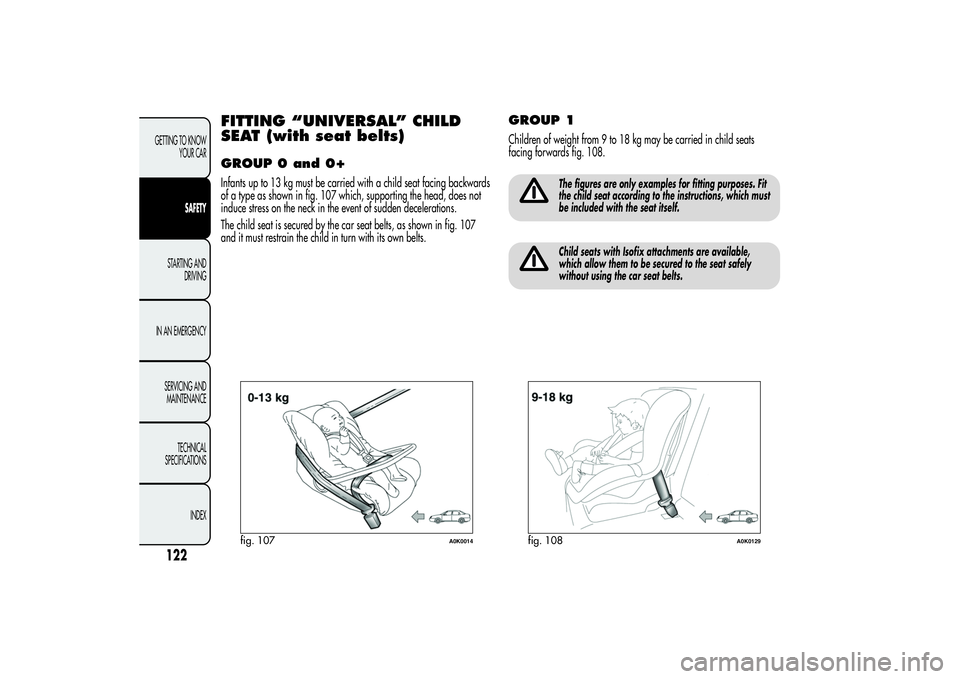
FITTING “UNIVERSAL” CHILD
SEAT (with seat belts)GROUP 0 and 0+Infants up to 13 kg must be carried with a child seat facing backwards
of a type as shown in fig. 107 which, supporting the head, does not
induce stress on the neck in the event of sudden decelerations.
The child seat is secured by the car seat belts, as shown in fig. 107
and it must restrain the child in turn with its own belts.
GROUP 1Children of weight from 9 to 18 kg may be carried in child seats
facing forwards fig. 108.
The figures are only examples for fitting purposes. Fit
the child seat according to the instructions, which must
be included with the seat itself.Child seats with Isofix attachments are available,
which allow them to be secured to the seat safely
without using the car seat belts.
fig. 107
A0K0014
fig. 108
A0K0129
122GETTING TO KNOW
YOUR CAR
SAFETY
STARTING AND
DRIVING
IN AN EMERGENCY
SERVICING AND
MAINTENANCE
TECHNICAL
SPECIFICATIONS
INDEX
Page 127 of 292
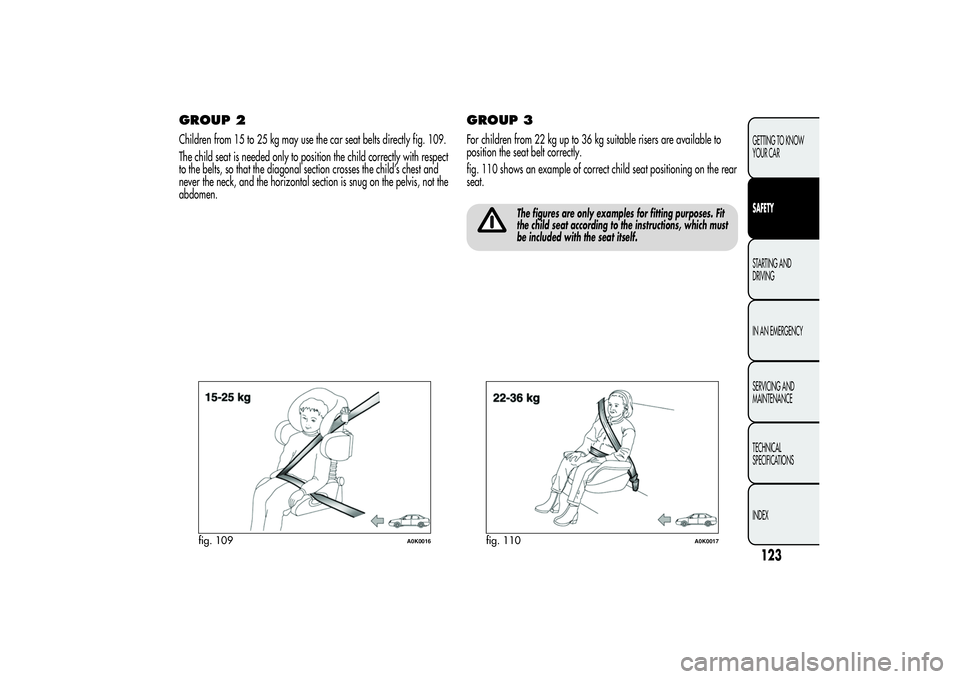
GROUP 2Children from 15 to 25 kg may use the car seat belts directly fig. 109.
The child seat is needed only to position the child correctly with respect
to the belts, so that the diagonal section crosses the child’s chest and
never the neck, and the horizontal section is snug on the pelvis, not the
abdomen.
GROUP 3For children from 22 kg up to 36 kg suitable risers are available to
position the seat belt correctly.
fig. 110 shows an example of correct child seat positioning on the rear
seat.
The figures are only examples for fitting purposes. Fit
the child seat according to the instructions, which must
be included with the seat itself.
fig. 109
A0K0016
fig. 110
A0K0017
123GETTING TO KNOW
YOUR CARSAFETYSTARTING AND
DRIVING
IN AN EMERGENCY
SERVICING AND
MAINTENANCE
TECHNICAL
SPECIFICATIONS
INDEX
Page 128 of 292
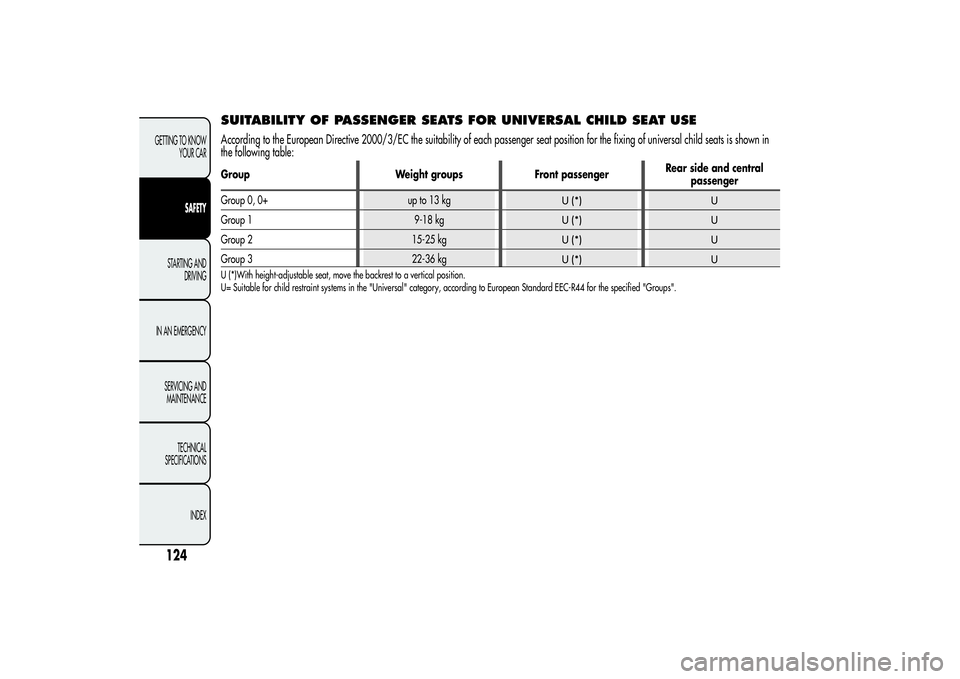
SUITABILITY OF PASSENGER SEATS FOR UNIVERSAL CHILD SEAT USEAccording to the European Directive 2000/3/EC the suitability of each passenger seat position for the fixing of universal child seats is shown in
the following table:Group Weight groups Front passengerRear side and central
passenger
Group 0, 0+ up to 13 kg
U (*) U
Group 1 9-18 kg
U (*) U
Group 2 15-25 kg
U (*) U
Group 3 22-36 kg
U (*) U
U (*)With height-adjustable seat, move the backrest to a vertical position.
U= Suitable for child restraint systems in the "Universal" category, according to European Standard EEC-R44 for the specified "Groups".
124GETTING TO KNOW
YOUR CAR
SAFETY
STARTING AND
DRIVING
IN AN EMERGENCY
SERVICING AND
MAINTENANCE
TECHNICAL
SPECIFICATIONS
INDEX
Page 129 of 292
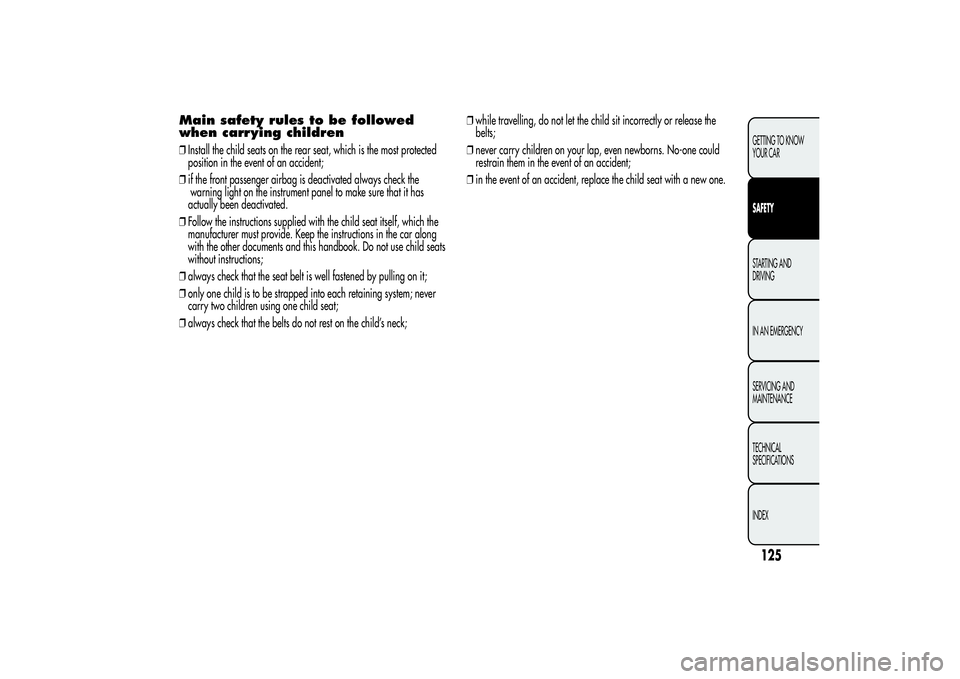
Main safety rules to be followed
when carrying children❒Install the child seats on the rear seat, which is the most protected
position in the event of an accident;
❒if the front passenger airbag is deactivated always check the
warning light on the instrument panel to make sure that it has
actually been deactivated.
❒Follow the instructions supplied with the child seat itself, which the
manufacturer must provide. Keep the instructions in the car along
with the other documents and this handbook. Do not use child seats
without instructions;
❒always check that the seat belt is well fastened by pulling on it;
❒only one child is to be strapped into each retaining system; never
carry two children using one child seat;
❒always check that the belts do not rest on the child’s neck;❒while travelling, do not let the child sit incorrectly or release the
belts;
❒never carry children on your lap, even newborns. No-one could
restrain them in the event of an accident;
❒in the event of an accident, replace the child seat with a new one.
125GETTING TO KNOW
YOUR CARSAFETYSTARTING AND
DRIVING
IN AN EMERGENCY
SERVICING AND
MAINTENANCE
TECHNICAL
SPECIFICATIONS
INDEX
Page 130 of 292
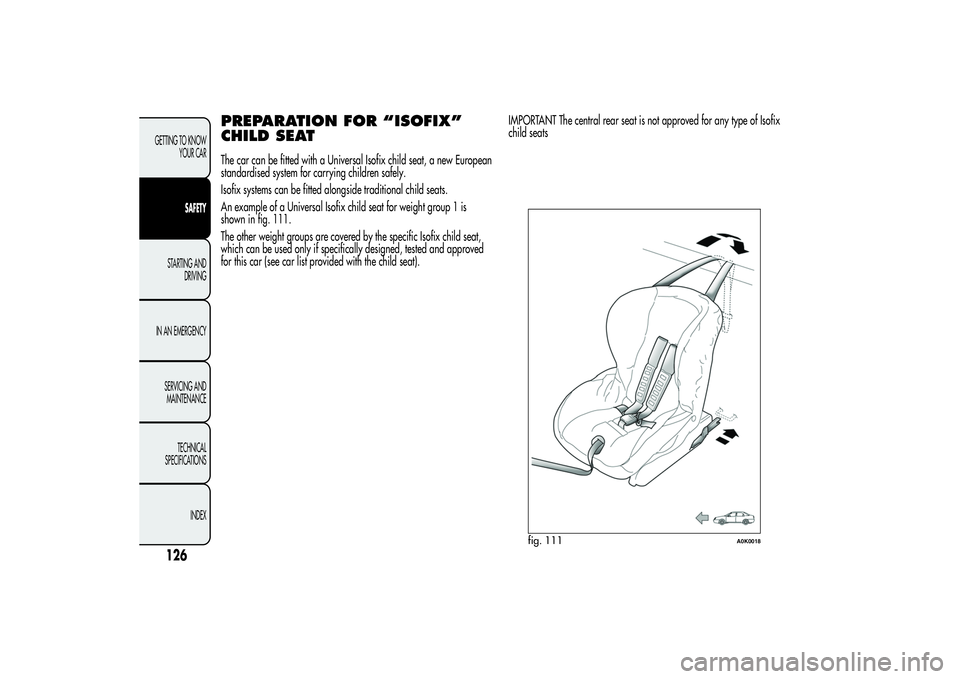
PREPARATION FOR “ISOFIX”
CHILD SEATThe car can be fitted with a Universal Isofix child seat, a new European
standardised system for carrying children safely.
Isofix systems can be fitted alongside traditional child seats.
An example of a Universal Isofix child seat for weight group 1 is
shown in fig. 111.
The other weight groups are covered by the specific Isofix child seat,
which can be used only if specifically designed, tested and approved
for this car (see car list provided with the child seat).IMPORTANT The central rear seat is not approved for any type of Isofix
child seats
fig. 111
A0K0018
126GETTING TO KNOW
YOUR CAR
SAFETY
STARTING AND
DRIVING
IN AN EMERGENCY
SERVICING AND
MAINTENANCE
TECHNICAL
SPECIFICATIONS
INDEX
Page 131 of 292
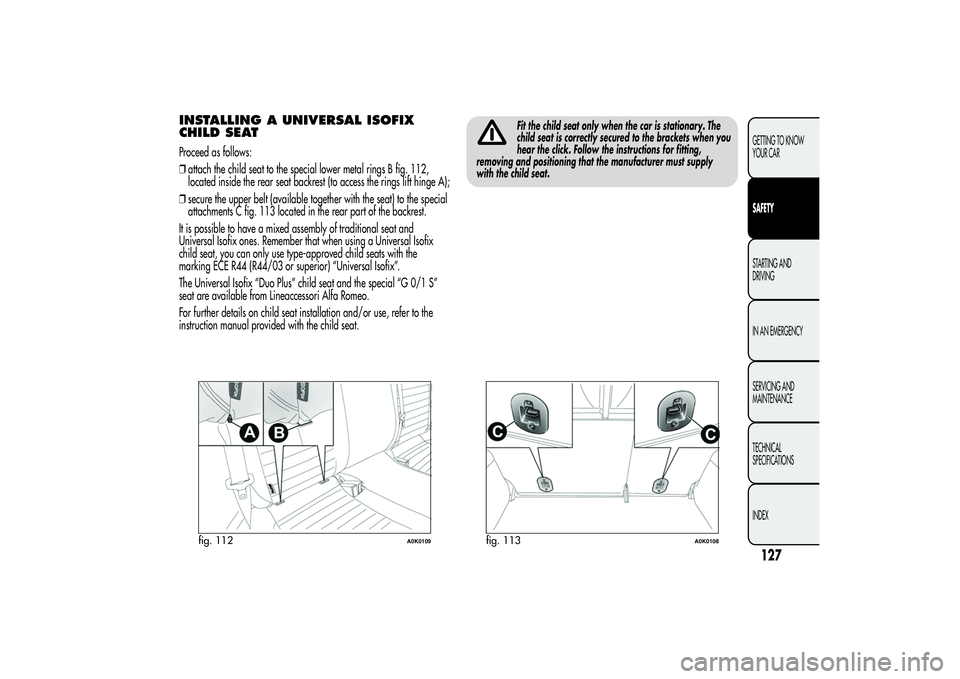
INSTALLING A UNIVERSAL ISOFIX
CHILD SEATProceed as follows:
❒attach the child seat to the special lower metal rings B fig. 112,
located inside the rear seat backrest (to access the rings lift hinge A);
❒secure the upper belt (available together with the seat) to the special
attachments C fig. 113 located in the rear part of the backrest.
It is possible to have a mixed assembly of traditional seat and
Universal Isofix ones. Remember that when using a Universal Isofix
child seat, you can only use type-approved child seats with the
marking ECE R44 (R44/03 or superior) “Universal Isofix”.
The Universal Isofix “Duo Plus” child seat and the special “G 0/1 S”
seat are available from Lineaccessori Alfa Romeo.
For further details on child seat installation and/or use, refer to the
instruction manual provided with the child seat.
Fit the child seat only when the car is stationary. The
child seat is correctly secured to the brackets when you
hear the click. Follow the instructions for fitting,
removing and positioning that the manufacturer must supply
with the child seat.
fig. 112
A0K0109
fig. 113
A0K0108
127GETTING TO KNOW
YOUR CARSAFETYSTARTING AND
DRIVING
IN AN EMERGENCY
SERVICING AND
MAINTENANCE
TECHNICAL
SPECIFICATIONS
INDEX
Page 132 of 292
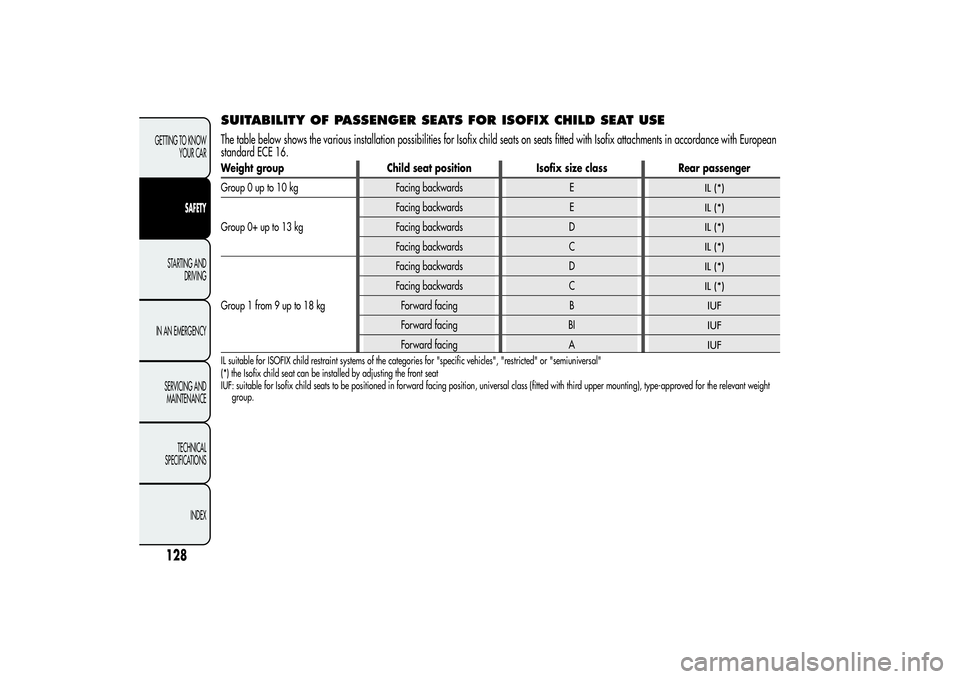
SUITABILITY OF PASSENGER SEATS FOR ISOFIX CHILD SEAT USEThe table below shows the various installation possibilities for Isofix child seats on seats fitted with Isofix attachments in accordance with European
standard ECE 16.Weight group Child seat position Isofix size class Rear passenger
Group 0 up to 10 kg Facing backwards E
IL (*)
Group 0+ up to 13 kgFacing backwards E
IL (*)
Facing backwards D
IL (*)
Facing backwards C
IL (*)
Group 1 from 9 up to 18 kgFacing backwards D
IL (*)
Facing backwards C
IL (*)
Forward facing B
IUF
Forward facing BI
IUF
Forward facing A
IUF
IL suitable for ISOFIX child restraint systems of the categories for "specific vehicles", "restricted" or "semiuniversal"
(*) the Isofix child seat can be installed by adjusting the front seat
IUF: suitable for Isofix child seats to be positioned in forward facing position, universal class (fitted with third upper mounting), type-approvedfor the relevant weight
group.
128GETTING TO KNOW
YOUR CAR
SAFETY
STARTING AND
DRIVING
IN AN EMERGENCY
SERVICING AND
MAINTENANCE
TECHNICAL
SPECIFICATIONS
INDEX
Page 133 of 292
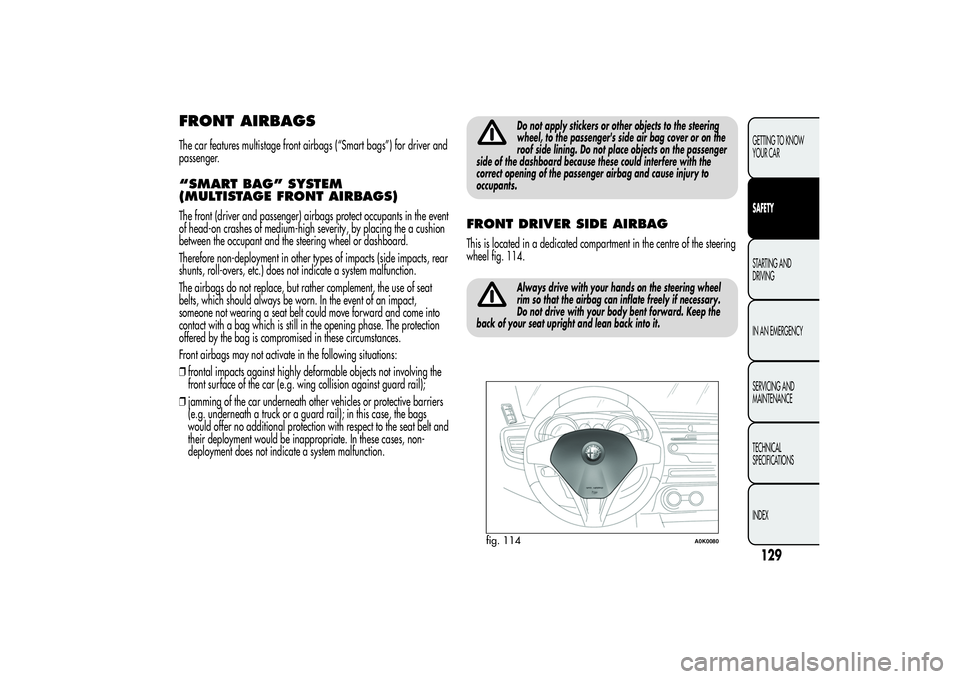
FRONT AIRBAGSThe car features multistage front airbags (“Smart bags”) for driver and
passenger.“SMART BAG” SYSTEM
(MULTISTAGE FRONT AIRBAGS)The front (driver and passenger) airbags protect occupants in the event
of head-on crashes of medium-high severity, by placing the a cushion
between the occupant and the steering wheel or dashboard.
Therefore non-deployment in other types of impacts (side impacts, rear
shunts, roll-overs, etc.) does not indicate a system malfunction.
The airbags do not replace, but rather complement, the use of seat
belts, which should always be worn. In the event of an impact,
someone not wearing a seat belt could move forward and come into
contact with a bag which is still in the opening phase. The protection
offered by the bag is compromised in these circumstances.
Front airbags may not activate in the following situations:
❒frontal impacts against highly deformable objects not involving the
front surface of the car (e.g. wing collision against guard rail);
❒jamming of the car underneath other vehicles or protective barriers
(e.g. underneath a truck or a guard rail); in this case, the bags
would offer no additional protection with respect to the seat belt and
their deployment would be inappropriate. In these cases, non-
deployment does not indicate a system malfunction.
Do not apply stickers or other objects to the steering
wheel, to the passenger's side air bag cover or on the
roof side lining. Do not place objects on the passenger
side of the dashboard because these could interfere with the
correct opening of the passenger airbag and cause injury to
occupants.
FRONT DRIVER SIDE AIRBAGThis is located in a dedicated compartment in the centre of the steering
wheel fig. 114.
Always drive with your hands on the steering wheel
rim so that the airbag can inflate freely if necessary.
Do not drive with your body bent forward. Keep the
back of your seat upright and lean back into it.
fig. 114
A0K0080
129GETTING TO KNOW
YOUR CARSAFETYSTARTING AND
DRIVING
IN AN EMERGENCY
SERVICING AND
MAINTENANCE
TECHNICAL
SPECIFICATIONS
INDEX
Page 134 of 292
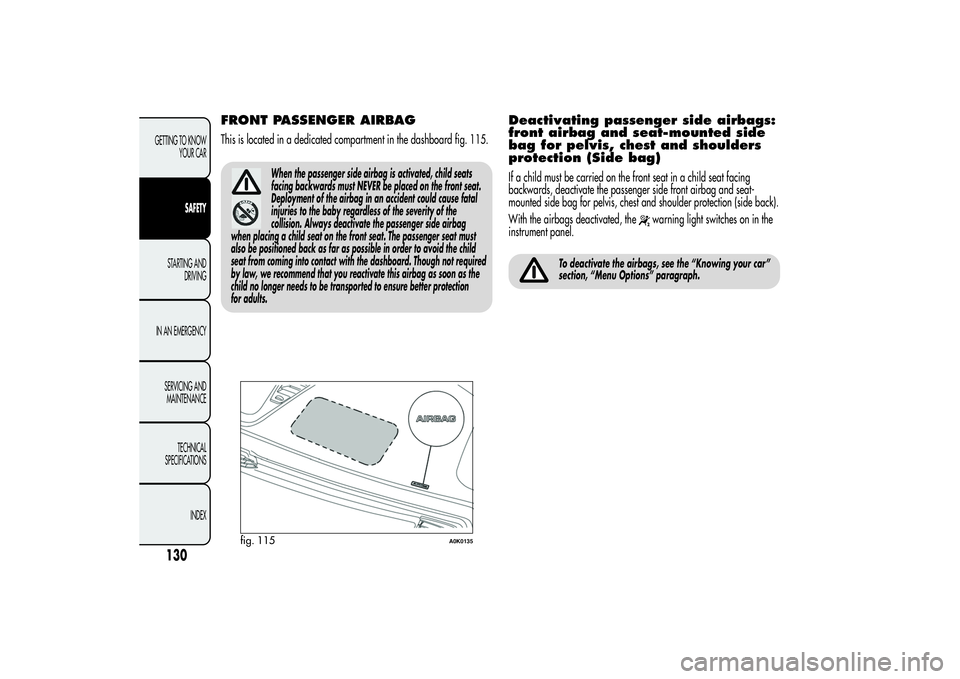
FRONT PASSENGER AIRBAGThis is located in a dedicated compartment in the dashboard fig. 115.
When the passenger side airbag is activated, child seats
facing backwards must NEVER be placed on the front seat.
Deployment of the airbag in an accident could cause fatal
injuries to the baby regardless of the severity of the
collision. Always deactivate the passenger side airbag
when placing a child seat on the front seat. The passenger seat must
also be positioned back as far as possible in order to avoid the child
seat from coming into contact with the dashboard. Though not required
by law, we recommend that you reactivate this airbag as soon as the
child no longer needs to be transported to ensure better protection
for adults.
Deactivating passenger side airbags:
front airbag and seat-mounted side
bag for pelvis, chest and shoulders
protection (Side bag)If a child must be carried on the front seat in a child seat facing
backwards, deactivate the passenger side front airbag and seat-
mounted side bag for pelvis, chest and shoulder protection (side back).
With the airbags deactivated, the
warning light switches on in the
instrument panel.
To deactivate the airbags, see the “Knowing your car”
section, “Menu Options” paragraph.
fig. 115
A0K0135
130GETTING TO KNOW
YOUR CAR
SAFETY
STARTING AND
DRIVING
IN AN EMERGENCY
SERVICING AND
MAINTENANCE
TECHNICAL
SPECIFICATIONS
INDEX
Page 135 of 292
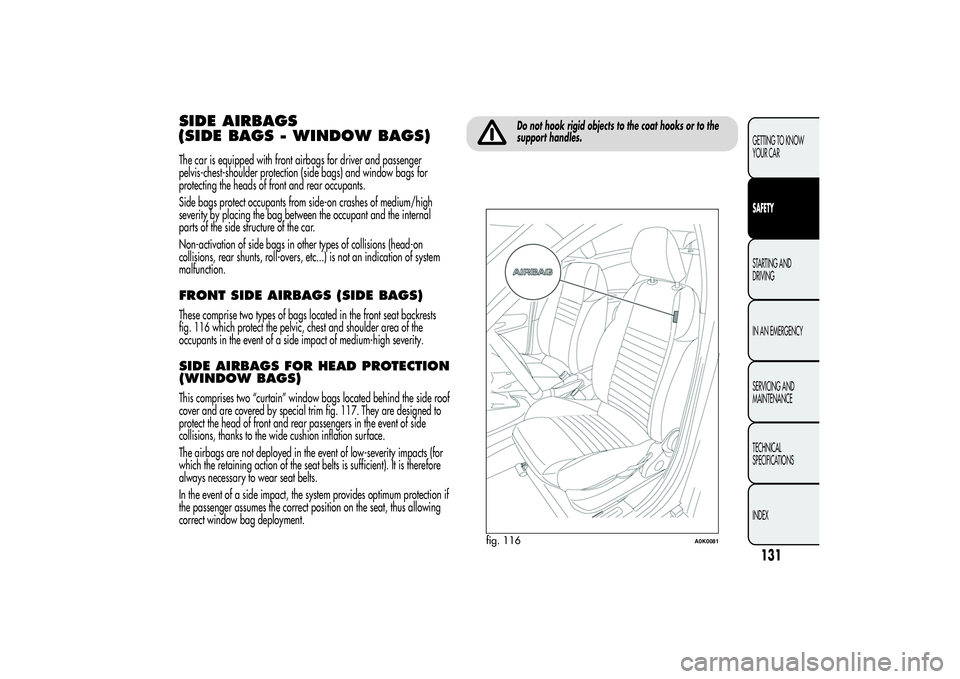
SIDE AIRBAGS
(SIDE BAGS - WINDOW BAGS)The car is equipped with front airbags for driver and passenger
pelvis-chest-shoulder protection (side bags) and window bags for
protecting the heads of front and rear occupants.
Side bags protect occupants from side-on crashes of medium/high
severity by placing the bag between the occupant and the internal
parts of the side structure of the car.
Non-activation of side bags in other types of collisions (head-on
collisions, rear shunts, roll-overs, etc...) is not an indication of system
malfunction.FRONT SIDE AIRBAGS (SIDE BAGS)These comprise two types of bags located in the front seat backrests
fig. 116 which protect the pelvic, chest and shoulder area of the
occupants in the event of a side impact of medium-high severity.SIDE AIRBAGS FOR HEAD PROTECTION
(WINDOW BAGS)This comprises two “curtain” window bags located behind the side roof
cover and are covered by special trim fig. 117. They are designed to
protect the head of front and rear passengers in the event of side
collisions, thanks to the wide cushion inflation surface.
The airbags are not deployed in the event of low-severity impacts (for
which the retaining action of the seat belts is sufficient). It is therefore
always necessary to wear seat belts.
In the event of a side impact, the system provides optimum protection if
the passenger assumes the correct position on the seat, thus allowing
correct window bag deployment.
Do not hook rigid objects to the coat hooks or to the
support handles.
fig. 116
A0K0081
131GETTING TO KNOW
YOUR CARSAFETYSTARTING AND
DRIVING
IN AN EMERGENCY
SERVICING AND
MAINTENANCE
TECHNICAL
SPECIFICATIONS
INDEX